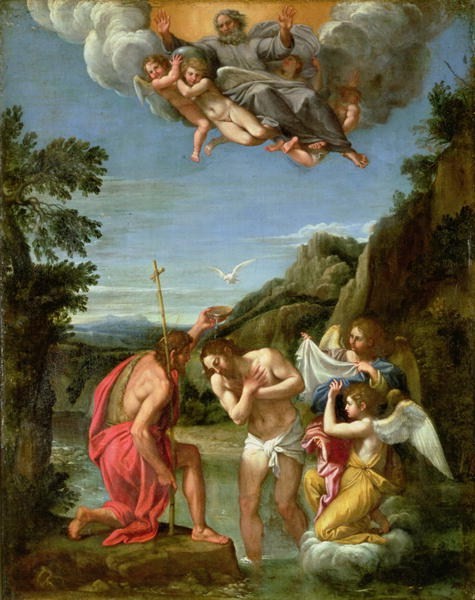
Strelan’s article on the Fallen Watchers and the Disciples in Mark led me to a 1981 article by George W. E. Nickelsburg of particular interest: Enoch, Levi, and Peter: Recipients of Revelation in Upper Galilee (JBL 100/4 (1981) 575-600). I suspect Nickelsburg is touching on aspects of the Book of Enoch that ought to have major significance for the question of Christian origins, and in particular for the origin of the geographic symbolism we encounter in the Gospel of Mark. The idea that Galilee represents the place of the Kingdom of God while Jerusalem is in bondage to archons and apostasy is not original to the Gospel of Mark. Mark seems to have inherited this among a number of other ideas from those we find also in the Book of Enoch.
But here I share just one detail from this article, one that has to do with the baptism of Jesus as the means of his entry into the narrative of the gospel.
This is Nickelsburg’s sentence that caught my eye:
At the sacred place, [Enoch] sits down by the waters — traditionally a place of revelation — and reads himself into a trance in which he is conveyed into the presence of God.
Here Milik (Le Testament de Lévi, Revue Biblique, 62 (1955) 405) is referenced as citing the following:
Ezekiel 1:1
Now it came to pass in the thirtieth year . . . as I was among the captives by the River Chebar, that the heavens were opened and I saw visions of God.
Daniel 10:4-7
I was by the side of the great river, that is, the Tigris. I lifted my eyes and looked, and behold, a certain man clothed in linen, whose waist was girded with gold of Uphaz! His body was like beryl, his face like the appearance of lightning, his eyes like torches of fire, his arms and feet like burnished bronze in colour, and the sound of his words like the voice of a multitude. And I, Daniel, alone saw the vision, for the men who were with me did not see the vision; but a great terror fell upon them, so that they fled to hide themselves.
And the Enochian passage in question is
Enoch 13:7-8
7. And I went off and sat down at the waters of Dan, in the land of Dan, to the south of the west of Hermon: I read their petition till I fell asleep. 8. And behold a dream came to me, and visions fell down upon me, and I saw visions of chastisement, ⌈and a voice came bidding (me) I to tell it to the sons of heaven, and reprimand them.
Nickelsburg compares with these passages Jesus’ baptism:
Mark 1:9-11
[9] And it came to pass in those days, that Jesus came from Nazareth of Galilee, and was baptized of John in Jordan.
[10] And straightway coming up out of the water, he saw the heavens opened, and the Spirit like a dove descending upon him:
[11] And there came a voice from heaven, saying, Thou art my beloved Son, in whom I am well pleased.
It seems so obvious once it’s pointed out, but I had never before seen the miraculous events of Jesus’ baptism — the heavens being opened, his revelation (and adoption?) as the Son of God, the heavenly voice and messenger dove — within the context of a traditional association of rivers and revelation.
This is surely one more detail to be added to list that invites us to see the Jesus story having been conceived in the matrix of Second Temple religious literature
Of most interest is Nickelsburg’s discussion pointing out the Galilean setting of Enoch’s visions and commissioning to the Fallen Watchers or angels who were responsible for the evil in the world. (Enoch blames the fallen angels for this, and appears to know nothing, or at least to have no interest in, the “fall of Adam” story.)
Jesus’ baptism, he notes, is uniformly set in the lower Jordan River area according to all later tradition. The Gospel of John also sets it there. The question this raises for me is this: Is this “tradition” associating the baptism with Jesus at the lower Jordan area related to those Christians who saw Jerusalem itself as a symbolic and/or literal centre for Christian origins? John’s gospel certainly has Jesus performing most of his revelatory speeches at Jerusalem, and the disciples are breathed with the Holy Spirit while there. In Mark’s gospel, however, Jerusalem and its Temple are clearly the focus of all that is opposed to Jesus and Christianity. It is only a very minor point, but it is of a little interest to think that Jesus’ baptism might originally have been envisaged as taking place much further north, even as far north as the place where the Jordan River began.
But this really matters little. I’m fascinated most by the Enoch-Mark resonances that locate the place of God’s revelation in Galilee, and stand opposed to the earthly priests and Temple of Jerusalem.
There is much else by way of correspondence between Mark and Enoch, and even between early Christianity generally and Enoch. Not surprising, of course, since we find NT epistles quoting from the Book of Enoch.
I look forward to sharing a little more of the Nickelsburg article with those without convenient access to it.
Neil Godfrey
Latest posts by Neil Godfrey (see all)
- Comparing Samaria and Judah/Yehud – and their religion – in Persian Times - 2024-04-20 07:15:59 GMT+0000
- Samaria in the Persian Period - 2024-04-15 11:49:57 GMT+0000
- No Evidence Jerusalem/Judea had a “Writing Culture” in Persian times — Israel Finkelstein - 2024-04-12 09:45:34 GMT+0000
If you enjoyed this post, please consider donating to Vridar. Thanks!
